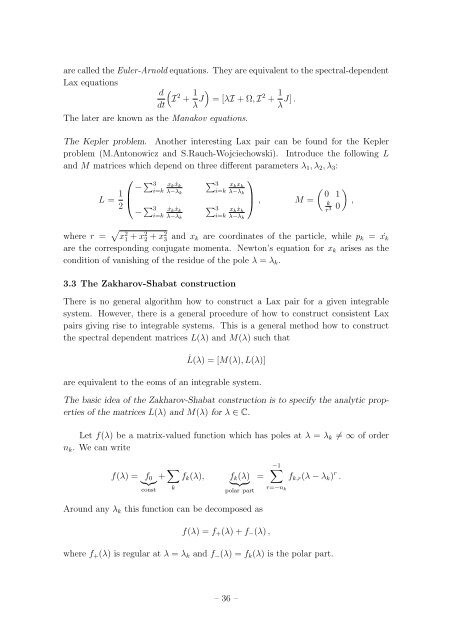Student Seminar: Classical and Quantum Integrable Systems
Student Seminar: Classical and Quantum Integrable Systems
Student Seminar: Classical and Quantum Integrable Systems
You also want an ePaper? Increase the reach of your titles
YUMPU automatically turns print PDFs into web optimized ePapers that Google loves.
are called the Euler-Arnold equations. They are equivalent to the spectral-dependent<br />
Lax equations<br />
d<br />
(I 2 + 1 )<br />
dt λ J = [λI + Ω, I 2 + 1 λ J] .<br />
The later are known as the Manakov equations.<br />
The Kepler problem. Another interesting Lax pair can be found for the Kepler<br />
problem (M.Antonowicz <strong>and</strong> S.Rauch-Wojciechowski). Introduce the following L<br />
<strong>and</strong> M matrices which depend on three different parameters λ 1 , λ 2 , λ 3 :<br />
⎛<br />
L = 1 ⎜<br />
⎝<br />
2<br />
− ∑ 3<br />
i=k<br />
− ∑ 3<br />
i=k<br />
x k ẋ k<br />
λ−λ k<br />
ẋ k ẋ k<br />
λ−λ k<br />
∑ 3<br />
i=k<br />
∑ 3<br />
i=k<br />
⎞<br />
x k x k<br />
λ−λ k<br />
x k ẋ k<br />
λ−λ k<br />
⎟<br />
⎠ , M =<br />
( ) 0 1<br />
,<br />
k<br />
0<br />
r 3<br />
where r = √ x 2 1 + x 2 2 + x 2 3 <strong>and</strong> x k are coordinates of the particle, while p k = x˙<br />
k<br />
are the corresponding conjugate momenta. Newton’s equation for x k arises as the<br />
condition of vanishing of the residue of the pole λ = λ k .<br />
3.3 The Zakharov-Shabat construction<br />
There is no general algorithm how to construct a Lax pair for a given integrable<br />
system. However, there is a general procedure of how to construct consistent Lax<br />
pairs giving rise to integrable systems. This is a general method how to construct<br />
the spectral dependent matrices L(λ) <strong>and</strong> M(λ) such that<br />
˙L(λ) = [M(λ), L(λ)]<br />
are equivalent to the eoms of an integrable system.<br />
The basic idea of the Zakharov-Shabat construction is to specify the analytic properties<br />
of the matrices L(λ) <strong>and</strong> M(λ) for λ ∈ C.<br />
Let f(λ) be a matrix-valued function which has poles at λ = λ k ≠ ∞ of order<br />
n k . We can write<br />
f(λ) = f 0 }{{}<br />
const<br />
+ ∑ k<br />
f k (λ),<br />
f k (λ) =<br />
} {{ }<br />
polar part<br />
∑−1<br />
r=−n k<br />
f k,r (λ − λ k ) r .<br />
Around any λ k this function can be decomposed as<br />
f(λ) = f + (λ) + f − (λ) ,<br />
where f + (λ) is regular at λ = λ k <strong>and</strong> f − (λ) = f k (λ) is the polar part.<br />
– 36 –

















